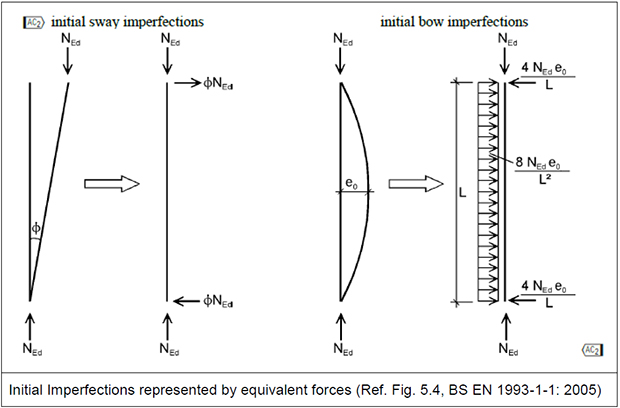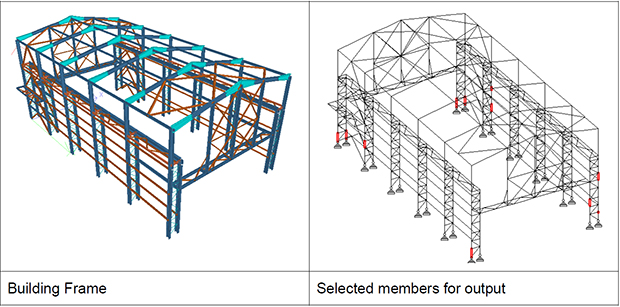
Structural design is generally carried out through development of mathematical model in computer software based on the geometry planned according to layout and functional requirements. However, during construction stage comprising of activities of fabrication of the members and erection in place, deviations occur which are then verified against acceptable limits of tolerance generally specified by various codes of practice. These deviations termed as imperfections are however departure from the form assumed in the analysis model and impose additional strains and stresses on the structural members. This article aims to present a case study where the considerations of imperfect geometry were modelled and calculated to arrive at a more practical design that accounted for construction stage deviations of building geometry during the structure analysis stage. This work demonstrates TCE’s capability to adopt the advanced analysis tools for modelling of structures that will reflect actual as built conditions and more predictable behaviour.
Introduction
Structures are made up of various members connected together to support loads from service components and provide a path to transfer these loads to the support in the ground through foundation elements. In general, the structures are modelled as prismatic sections of perfectly defined geometry during analysis in various software packages. However, in reality physical members are never perfect in the manner they are modelled in analysis tools. Further, the tools used for analysis are based on numerical solution procedures to idealize the complex structure into a mathematical model that is capable of being resolved to yield desired solutions. Such mathematical idealization has intrinsic approximations based on the mathematical principles used. Thus the apparently perfect structural analysis is only a close approximation of the actual behaviour.
The various types of physical imperfections that can occur in structures can be imperfections of member shape during manufacturing process of the structural section; imperfections built in during fabrication of member like holes, local change in grains and locked stresses near welds; load imperfections like eccentricity of compressive loads, small lateral loads or fluctuations that are not modelled; and support imperfections of idealized boundary conditions assumed in analysis. Some types of structures like thin members are sensitive to imperfection effects and hence the effects of these imperfections need to be studied during analysis of structural systems.
Numerical imperfections are artificially introduced into structural analysis to trigger specific response, some examples being “nudge” in bifurcation analysis and random state deviations to eliminate singularities in stiffness matrix.
Provisions for Imperfection Analysis
The BIS code IS 800: 2007, Code of Practice - General Construction in Steel does not explicitly specify consideration of imperfection modelling and analysis. Provisions for considering the effects of imperfections in analysis of structures are specified in Eurocode 3: Design of Steel Structures – Part 1-1 (EN 1993-1-1: 2005) and also in ANSI AISC 360-16: Specification for Structural Steel Buildings. This section briefly describes the provisions in these two widely accepted codes of practice for design of steel structures.
EN 1993-1-1: 2005 provides specification for consideration of imperfection for global analysis of frames, imperfection for analysis of bracing systems and local imperfections for individual members. The allowances specified provide for imperfections like non-verticality of frame, frame members not straight or flat and fitment of members not within acceptable tolerances at joints of unloaded structure. The shapes of global imperfections are derived from elastic buckling analysis for in plane, out of plane and torsional modes. In case of frames where sway effects are pronounced, equivalent imperfection in form of initial sway and bowing of members is considered. In case of bracing systems, geometric imperfection is modelled with initial bow of the members. The initial imperfections are substituted in the analysis by equivalent horizontal forces. Local member imperfections of bowed shape are accounted for in the formulae for buckling resistance of members.

The effect of initial imperfection is also considered in evaluation of buckling strength of members. An imperfection factor corresponding to appropriate buckling class of the section is used for evaluating the buckling resistance value of the member. This factor related to buckling analysis is included in IS 800.
Imperfection Analysis through software
The analysis of the structure for consideration of member imperfection is carried out through Staad software. The type of analysis to be carried out is decided based on buckling factor value. The first step of analysis is carried out to ascertain the buckling factor of the members. If this factor does not exceed the limiting values specified in EN 1993-1-1:2005, only first order analysis is carried out, otherwise second order analysis is carried out for the structure using concept of notional loads.
Imperfection Analysis Case study
In one project being engineered by TCE for design of material handling system, ore unloading is done in wagon tippler machine (termed as car dumper). The machine is housed inside a steel shed of length 41.0m, width 22.5m and height 16.185m with columns resting on walls of the dumper vault. The building has a 12MT capacity crane for equipment maintenance. The frame structure of this structural steel shed building was taken up for imperfection analysis in Staad. The results were compared with normal first order analysis with nominal geometry. The results of structure deflection and member forces are compared to demonstrate the influence of imperfections on the results.

© Tata Consulting Engineers Limited. All Rights Reserved | Site Credits:DV






